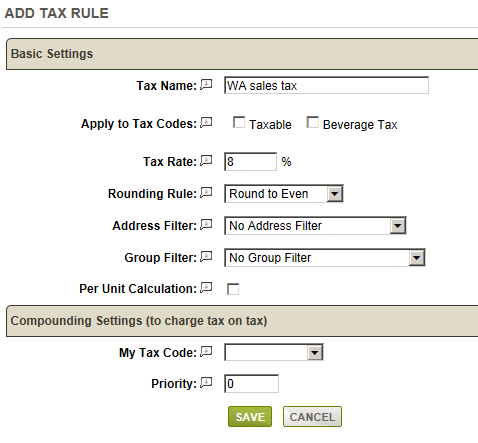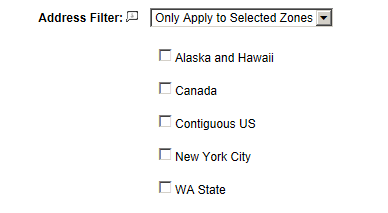Configure > Taxes
Tax Rules
AbleCommerce uses your tax rules to determine the requirements of a tax and to accurately calculate the amount of tax for an order. Each tax rule applies to a specific location that you define by creating zones. Each tax rule has a single rate applied. The tax rule is then associated to a tax code, and the tax code is associated to a product. A tax code can be applied to products, shipping charges, or gift wrap.
If the order contains any items with a tax code assigned, each rule of the tax code is checked against the user's shipping or billing address to see if there will be any taxes applied to the order. If the tax rule applies to the order, then all products, shipping, or gift wrap charges are checked separately for taxability and rates are applied accordingly. For less confusion, product, shipping, and gift wrap taxes are combined into a single line item for each tax rule.
|
NOTE: |
Before setting up tax rules, you should have already defined geographical regions, or zones, so that you can specify where your tax rule will apply to. |
Add a Tax Rule
You can add a new tax rule and assign it to a tax code.
-
From the Configure Taxes page, click the Tax Rules link, or go directly to Configure > Taxes > Tax Rules using the top menu.
- A default installation will have no tax rules setup. To create a tax rule, click the Add Tax Rule button in the lower-left corner to view a page similar to the one shown below.

-
Enter a Name for this tax rule. This will appear for both the customer and the merchant on invoices, receipts, etc. if you have selected the display option to show taxes separately from the Tax Settings page.
-
For the Apply to Tax Codes option, you must check a box next to all the tax codes that this tax rule will apply to. You can select more than one, but you must have a minimum of one tax code selected.
-
Enter the Tax Rate that will be applied to the taxable items in the customer's purchase. (e.g. 7.8 %) The number you enter will automatically be converted to a percent.
-
The Address Filter selection allows you to select a zone that defines a geographical region. This is where your tax rule will be applied to.

-
No Address Filter - this would apply the tax rule to every taxable product regardless of location. (not typical)
-
Only Apply to Selected Zones - check the box next to one or more zones that you have created.
-
-
If you apply your tax rule to an address filter, you will see a new selection on the page called Address Nexus. This option allows you to choose whether the customer's billing address or shipping address will be used to determine the taxable region.

You should consult your local tax authority before choosing this option. -
The Group Filter selection allows you to select a user group so the tax will only apply to users that belong to that group.

-
No Group Filter - this would apply the tax rule to all applicable users. (typical)
-
Only Apply to Selected Groups - check the box next to one or more user groups that you have created. The users belonging to these groups will be taxed according to the tax rule.
-
Do Not Apply to Selected Groups - check the box next to one or more user groups to exclude them from this tax rule.
-
-
Click the SAVE button to create your tax rule. The new tax rule will appear on the Tax Rules page.

-
From the Tax Rules page, you can use the EDIT icon to change the properties of a tax rule. This will bring up the tax rule in the right pane, Edit Tax Rule section.
-
You can click the DELETE icon to remove the tax rule and it's association to all tax codes.
-
Compounding Taxation
In the special case of compounding taxes, or where tax is calculated on tax, there is an option to select another tax code that should be used to charge tax on the selected tax rule. Compounding taxes are used in Canada, so we provide an example of how this can be setup in AbleCommerce.
Setting up Compounding Tax (example)
-
From the Configure Taxes page, click the Tax Rules link, or go directly to Configure > Taxes > Tax Rules using the top menu.
-
Create two tax rules using the following settings as a guide:

-
On checkout, for any address that applies to the tax rule, here is how the taxes are calculated for a product priced at $100.
Amount of Sale
$100.00
GST (5%)
$5.00
Sub-Total
$105.00
PST (10%)
$10.50
Total Payable
$115.50
Related Topics
Configure > Taxes > Tax Settings
Enable tax and setup basic display configurations.
Configure > Taxes > Tax Codes
Create a tax code to determine which tax rule(s) should be followed.
Configure > Regions > Zones
Use zones to offer shipping services and tax based on destinations.
Reports > Taxes
View tax amounts for each order and by tax rate.